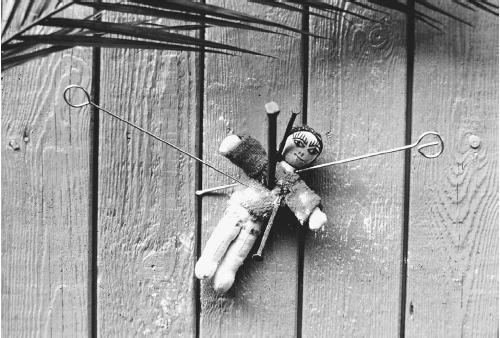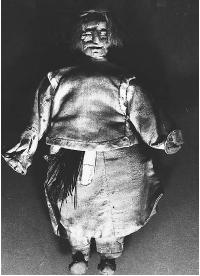Amulets
Voodoo dolls
To accomplish the placing a curse or a spell upon an individual, many magic traditions utilize a wax or cloth image to represent a hated enemy or a desired loved one. To properly effect such a spell or curse, it is generally required to obtain some personal bit of the object of one's intentions, i.e., nail parings, hair, excrement, saliva; and mix this in with soft wax or sew it in the cloth. Once this has been accomplished, the wax or pieces of cloth may be shaped into the form of either a male or female figure.
In the popular mind the so-called voodoo doll is the most well-known of such effigies, and many tourists have brought such souvenirs home from their visits to New Orleans or Haiti where Voudun (Voodoo) is practiced as a religion. Over the years, the portrayal of a voudun priest or priestess sticking pins into a doll that represents someone who has incurred their wrath has become so common that such effigies or puppets are known collectively as voodoo dolls. Actually, such figures have no role in the religion of voodoo, and the practice of sticking pins in dolls or poppets (puppets) is a custom of Western European witches, rather than the Haitian or Caribbean practitioners of voudun. Perhaps the misunderstanding arose when outsiders who witnessed

One method of effigy cursing calls for the magician to fashion a wax or cloth skeleton and to inscribe the name of the intended victim on its back. The image is then pierced with a thorn or a sharpened twig in the area corresponding to the victim's body part that the sorcerer desires to inflict with pain. Once pierced, the skeleton is wrapped in a shroud and prayed over as if it were a deceased person. When the death-rites have been accomplished, the effigy must be buried in a spot over which the intended victim is certain to walk.
Waxen and cloth images may also be used to bring about unions of love, as well as terrible deeds of hatred and revenge. In order to weave a love spell with wax effigies, the magician fashions two hearts of wax, baptizes them with the lovers' names, and then joins the hearts together with three pins. The images are then given to the one who desires such a union so that she or he might press the wax hearts to her or his own heart.
When magicians are convinced that they themselves have been cursed, they might form an image, or puppet, to represent the one who has cast the malign spell. Once the magicians have fashioned such a puppet, they bury the box containing the puppet under a thin layer of soil. Over the soil, they light a bonfire and chant their wish that the curse set against them will be consumed along with the flames that burn the puppet representing the one who cursed them.


Comment about this article, ask questions, or add new information about this topic: